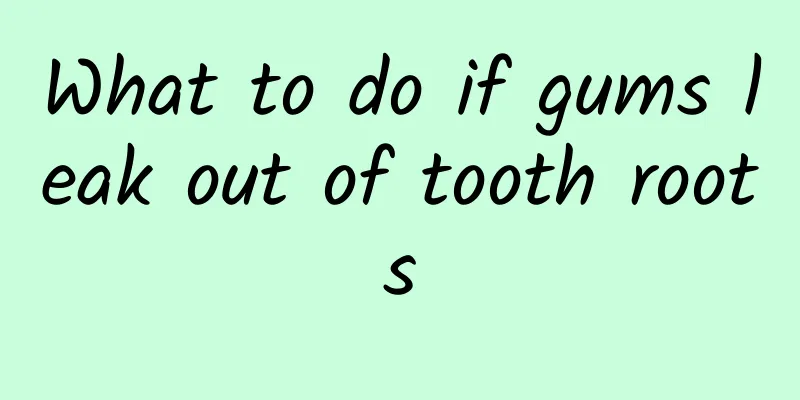What to do if gums leak out of tooth roots

|
The protrusion of the gums through the roots of the teeth is also called exposed gums. This condition is generally caused by gum atrophy. We know that the harm of gum atrophy is relatively large, and this type of gum atrophy is irreversible. It often makes the teeth more sensitive and abnormally sensitive to temperature and acidic foods, often causing irritating pain, etc. When this happens, it is necessary to receive good treatment in time. What to do if gums leak out of tooth roots Since gingival recession is accompanied by the absorption of the underlying alveolar bone, once the gums recede, except for a few affected teeth that can cover part of the exposed root surface through membranous gingival surgery, most of the gingival recession is difficult to regenerate and restore to the original height. Therefore, care should be taken to prevent gingival recession. Small, uniform amounts of gum recession are usually asymptomatic and require no treatment. If gingival recession continues to progress, the cause should be identified and eliminated (for example, changing brushing habits, adjusting orthodontic force, correcting poor restorations, etc.) to avoid further aggravation of gingival recession. In addition, symptomatic treatment should be given to the complications of gingival recession: for teeth with sensitive root surfaces, local stimulation should be reduced (avoid ingesting too cold or too hot food, brushing teeth with warm water, etc.), and desensitizing toothpaste should be used for desensitization; for a few patients whose symptoms seriously affect their eating, sodium fluoride paste (or % sodium fluoride solution) can be applied locally, fluoride-containing mineral solution can be used for gargling, etc. There is no special treatment for horizontal food impaction, so attention should be paid to timely cleaning. Dental floss and toothpicks can be used to clean the adjacent surfaces of teeth; teeth with root caries should be filled and treated in time.Causes of tooth root exposure First of all, the roots of the teeth do not grow directly on the alveolar bone (gum). There is a thick layer of gum tissue between them. This part of the gum is called "periodontal tissue" by modern oral medicine (perhaps it would be more vivid to call it inner gum). The periodontal tissue and alveolar bone are tightly wrapped by the outer gum. Therefore, the connection between teeth and alveolar bones is actually a joint relationship, which is a micro-motion joint (with a small range of motion) in the human body. Therefore, even if the teeth are strong and healthy, there will be a feeling of slight movement when touched by hand. The alveolar bone basically relies on the gum tissue that wraps it for nourishment. When the gums age and shrink, the ability to transport nutrients to the alveolar bone decreases, and the alveolar bone shrinks and becomes shorter. This is called "bone resorption phenomenon" in oral medicine. Gum atrophy causes the wrapping and maintaining strength of this "micro-motion joint" to decrease, and the teeth begin to loosen. At the same time, the alveolar bone is absorbed, making the tooth roots shallower and the teeth longer. As the bone absorption phenomenon becomes more and more severe, the teeth naturally fall off. On the other hand, after the gums shrink, they can no longer tightly wrap the tooth roots as before, resulting in the exposure of the periodontal tissue (inner gums). Various bacteria in the mouth (especially anaerobic bacteria) and dental tartar directly invade the periodontal tissue and cause periodontitis. Periodontitis will in turn aggravate gum recession and accelerate the absorption of alveolar bone, forming a vicious cycle. The result is not only the destruction of gums and teeth, but more seriously, it threatens physical health. Since current oral medicine believes that gum recession cannot be reversed, periodontitis cannot be cured, so it is listed by the World Health Organization as the third largest killer threatening human health. |
<<: What to do if the tooth root is rotten
>>: What should I do if a boy’s foreskin is too long?
Recommend
Can AIDS be cured in the early stages?
Once contracted with AIDS, the patient will suffe...
What is tongue muscle atrophy? What are the symptoms?
Many people are unfamiliar with muscular atrophy,...
What does raw, cold and spicy mean?
Eating cool food refers to raw and cool food, suc...
What to do when you wake up with swollen eyes in the morning
Many people have experienced swollen eyes after ge...
Health care for the kidneys first
Traditional Chinese medicine believes that the ki...
The efficacy and function of glutinous rice root
The Chinese medicinal material glutinous rice roo...
What to do if there is a cyst in the uterus? Chinese medicine diet therapy has a folk remedy
If a female friend has abnormal leucorrhea, somet...
What causes stomach pain?
Stomach health is a core health issue for people. ...
How to relieve breast engorgement and pain
For women who are breastfeeding, breast tendernes...
What is the cause of unstable heartbeat?
Many people think they are in good health, but wh...
How to delay menopause
People have reached middle age, which means that ...
What to do if you only fart but not poop after giving birth
Pregnant women need to take good care of themselv...
Glans sensitivity analysis
Many people actually don’t know that their glans ...
There is a pain in the left shoulder blade
Pain in the left shoulder blade is quite common i...
Insufficient heart and spleen, deficiency of qi and blood, good effect of TCM conditioning
Common causes of deficiency of Qi and blood inclu...









